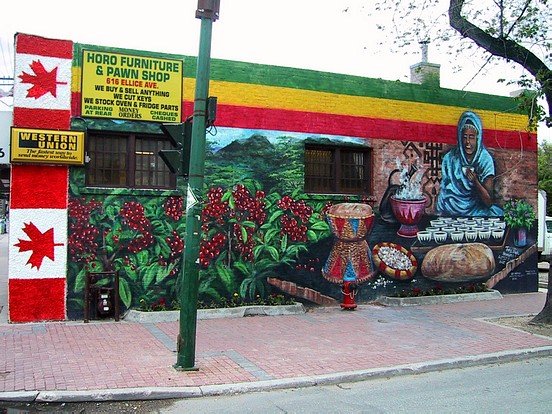|
|
|
|
|
|





|
|
616 Ellice Avenue
Location Map

Ethiopia is thought to be the first country to develop coffee into a thriving industry.
|
Location: SE corner Ellice & Maryland; West Face
Occupant: Bread N Biryani
District: West End
Neighbourhood: St. Matthews
Artist(s): Tom Andrich (Eclectic Fine Art)
Year: 2003
Sponsors: West End BIZ, Neighbourhoods Alive! (Manitoba), Take Pride Winnipeg!
Painters: Assisted by Andrea Kramer
|
|
|
Coffee Ceremony, an event that makes the country unique among coffee producing nations.
Ethiopians show an appreciation for coffee that is almost god-like in its tribute. Their homage to the
beverage is sometimes ornate, but always overtly ceremonial.
The ritual begins by spreading a bed of straw and then strewing fresh, colourful flowers on top.
Amidst this array is the centrepiece: the traditional black Ethiopian earthenware coffeepot; which is
filled with water and placed on top of hot coals. Nearby sits what looks like a hibachi grill, also filled
with hot wood coals. A large, open wok-shaped pan rests on top, and inside the pan green coffee
beans roast slowly. One person, usually a woman, conducts the cooking and the ceremony.
Normally, she has a few assistants who fetch water at the proper time and fan the coals to keep
them hot. She stirs the green coffee beans constantly so as not to burn them. Upon closer
inspection, however, many are over-roasted and some under-roasted.
The water reaches the appropriate temperature at about the same time the beans finish cooking.
The woman then dumps the hot beans into a hollow stump and uses a crude, mallet-shaped mortar
with a long handle to crush them. Specialty coffee professionals know the importance of a
consistent grind in the preparation of coffee. The archaic method used by Ethiopians, however,
results in a grind that can be called anything but even and yet still produces an outstanding cup of
coffee.
Finally, the woman dumps the coffee through the small opening at the top of the coffee vessel and
allows it to steep. After only a few minutes, an assistant arrives with a tray of small, demi-size
cups, and the conductor of the ceremony pours and serves the coffee to the family and friends who
have waited and watched the procedure for the past half-hour. They consume the beverage quickly.
Smiles and slurping generally accompany kudos about both taste and flavour. The coffee consumption obviously
has this very strong social aspect to it.
Tom Andrich: "The client and business owner is Ethiopian and wanted an Ethiopian
theme since nothing like that had yet been done. He suggested the Ethiopian coffee
ceremony. That's a really important aspect of Ethiopia because some of the best coffee in
the world grows wild in the mountains there, so I needed to show the beautiful mountains
as well. I researched on the net for pictures of Ethiopia, the coffee ceremony, the kind of
cups they of used what kinds of foods they had on the table, the pots they put the coffee
in. They have popcorn around, and bread. There is a great Ethiopian restaurant at Ellice
and Hargrave that have these articles right there."
"The woman is a composite from various pictures I saw. I had to change her a couple of
times- I didn't like her head! I used Ethiopian wall designs for the background and also
tried to make it look like a crude clay brick background. The colours running across the
top are the colours of the Ethiopian flag. The Canadian flags at the top and bottom left
corners were added at the request of the client, Mike Kindle. They look OK, I guess, but
I also think that they distract a bit from the rest of the Mural."
"I started this in 2002 but then it got cold. I didn't want to put a hoarding (scaffolding
and tarp with propane heating) there because there's just no room for it there on the
sidewalk and it's such a high pedestrian traffic area. So I finished it in the spring of 2003.
The surface was a very difficult one to work on- a highly textured brick surface with
crevices not just between the bricks but in the bricks. I did a lot of spraying because I
couldn't brush in there; and I would have to spray each area three times from different
angles to cover all the crevices. This served as the under painting and I would use my
brush to paint on top."
|
|